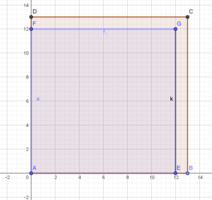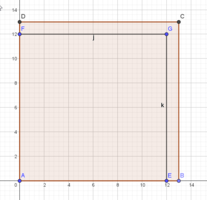Steven G
Elite Member
- Joined
- Dec 30, 2014
- Messages
- 14,603
(1 x^2+ 1x^1+1x^0)^2 = 1x^4 + 2x^3 + 3x^2 + 2x^1 + 1x^0
Consider two 3-sided dice both numbered 0, 1 and 2 (I have no idea why I said 4-sided dice in my previous post).
Now if you look at the Cayley table for the sum of the two dice, you'll see that you can get a sum of 0 in 1 way, 1 in 2 ways, 2 in 3 ways, 3 in 2 ways and a 4 in 1 way.
Consider 1x^2+ 1x^1+1x^0:
1x^2 means there is 1 face with a 2 on it
1x^1 means there is 1 face with a 1 on it
1x^0 means there is 1 face with a 0 on it
Now consider (1 x^2+ 1x^1+1x^0)^2 = 1x^4 + 2x^3 + 3x^2 + 2x^1 + 1x^0:
1x^4 means there is 1 way to get a sum of 4
2x^3 means there are 2 ways to get a sum of 3
3x^2 means there are 3 ways to get a sum of 2
2x^1 means there are 2 ways to get a sum of 1
1x^0 means there is 1 way to get a sum of 0.
I gave a talk on dice a short while ago and this equation you came up with made me think of my talk and gave me the factoring quite quickly.
Consider two 3-sided dice both numbered 0, 1 and 2 (I have no idea why I said 4-sided dice in my previous post).
Now if you look at the Cayley table for the sum of the two dice, you'll see that you can get a sum of 0 in 1 way, 1 in 2 ways, 2 in 3 ways, 3 in 2 ways and a 4 in 1 way.
Consider 1x^2+ 1x^1+1x^0:
1x^2 means there is 1 face with a 2 on it
1x^1 means there is 1 face with a 1 on it
1x^0 means there is 1 face with a 0 on it
Now consider (1 x^2+ 1x^1+1x^0)^2 = 1x^4 + 2x^3 + 3x^2 + 2x^1 + 1x^0:
1x^4 means there is 1 way to get a sum of 4
2x^3 means there are 2 ways to get a sum of 3
3x^2 means there are 3 ways to get a sum of 2
2x^1 means there are 2 ways to get a sum of 1
1x^0 means there is 1 way to get a sum of 0.
I gave a talk on dice a short while ago and this equation you came up with made me think of my talk and gave me the factoring quite quickly.


